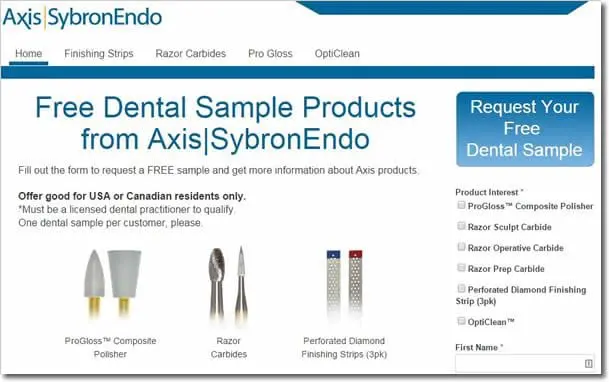A microsite is an individual web page or a small cluster of pages which are meant to function as a discrete entity within an existing website or to complement an offline activity. The microsite’s main landing page can have its own domain name or subdomain. ~ Wikipedia
A microsite is useful for highlighting a product, launching a promotion, or augmenting a marketing campaign in ways that a full website cannot. The small collection of pages on a microsite are meant to engage the user (usually very targeted audience) in something particular, without the distractions of the full company website.
Over the past year, we’ve worked with Sybron Dental on several microsites that were designed for either a promotion (free samples) or to launch a new product.
Microsite for free samples
The company wanted to make dentists aware of extended product families by getting products into dentists hands, so they decided to offer product samples to their customers and prospects. This campaign was supported by the field sales staff and a strong pay-per-click campaign in Google Adwords.

“Microsites give you some creative freedom and allows the user to be free of any associations or preconceived notions the brand might inspire,” says John Patroulis, chief creative officer at BBH New York. For our clients, microsites let brands be a little more flexible in their messaging and target certain groups without worrying about whether it works for everyone.
Microsites for new product introductions
Microsite can usually be put together very quickly. This new product introduction site was built in a couple days on HubSpot landing pages and a unique domain.
Sybron’s data indicated that a large number of dentists viewed previous microsites on smartphones, so a lot of attention was paid to how the sites looked on small devices, and specifically what order elements “stacked” on small screens.
In both of these microsites, webhooks delivered product and demo requests directly into the company’s CRM and out to the appropriate sales reps for immediate response.
Key Takeaways
Since microsites are separate from the larger brand websites, they remain flexible and focused. In order to have a successful microsite be to to think about the following 6 points:
- Identify your target audience for the campaign — when in doubt, go “narrow” and focus on messing for those specific people.
- Limit the site to one topic. What is the ONE thing you want someone to do on this site? Make it easy to do that.
- Include lots of high-quality information, in as many different formats as possible.
- Use a responsive design that is distinct from the brand website. Be sure to consider the overall user experience and the page-level experience. What happens if a user “lands” on other-than-the-home-page?
- Consider how you will drive traffic to this microsite, as the organic search approach won’t work well (small website, new domain, organic takes lots of time and nurturing). Think about PPC through the search engines and social media; think about email campaigns; think of other ways to reach out directly (and in new ways) to the audience you’re targeting.
- Track your results with a marketing automation system like HubSpot, to determine exactly what’s working and to fix what’s not working. Marketing automation and PPC work together as a great team!
